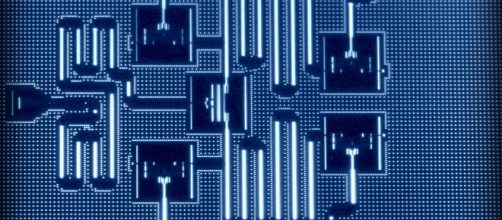Ever since it became possible to create qubits (quantum bits) and track their changes people have been trying to build Quantum Computers which should, theoretically, vastly outperform traditional digital computers for some tasks such as factoring large primes (encryption) and optimizing solutions. But it is still an open question as to whether they even work, let alone are faster.
Quantum dual
Two radically different approaches to building a quantum computer, one from IBM and the other from ionQ in Maryland, have been pitted against each other for the first time using identical algorithms.
One turned out to be faster and the other proved more reliable. This is the first time two quantum computers were stable enough to be compared.
Chris Monroe, a physicist at U Maryland founded a startup company ionQ to develop his computer using five ytterbium ions balanced in a magnetic field and manipulated by lasers. IBM's computer uses 5 loops of superconducting wire controlled by microwaves. That one can be accessed online like the time-share computers of pre-Internet days. That was necessary for Monroe’s team to design and run the experiment.
These are not supercomputers. In fact they are far less powerful than the original Tandy Color Computer and more akin to the early pre-microprocessor computers, less than the computing power of a digital watch, but still they are the first step and it’s important to recall how slow the original computers used in WWII, machines which weighed tons, actually were.
What is a quantum computer
It is very difficult to explain what a quantum computer is to anyone who doesn’t already understand quantum mechanics, but essentially they differ from the common digital computer because they don’t rely on two states. Digital computers use two position logic, on-off, yes-no, etc. Quantum computers rely on qubits, quantum bits, which have more than two states and can even exist in multiple states at once.
The foundation of quantum mechanics is that most physical phenomena at the atomic or subatomic level don’t have definite positions or states, rather they only have probabilities. That is terrible if you are balancing a checkbook, but very useful for some very complex problems where you want to calculate probabilities of multiple conditions simultaneously.
Digital computers need to do that one at a time but quantum computers may be able to deal with many multi-state problems simultaneously, producing answers in seconds which would take a supercomputer weeks or longer.
The important point to remember is that once a basic quantum computer works reliably the processor components can be doubled, tripled, and so on, with each increase in processors creating an exponential increase in calculating power.
Bottom line
Don’t expect to see one of these in Walmart next Christmas. Although the qubits themselves are pretty simple, they require extreme isolation from any environmental influence which can and does cause them to collapse into a base state. The IBM computer, using superconductive wire, must be kept at extremely low temperatures.
The ionQ computer was able to hit a 77% correct or successful run on a typical calculation while the IBM superconducting loop computer only produced the correct answer 35% of the time.
The failures are not due to the actual qubits but to the way they are connected and how many times signals must be exchanged between them - each such step is another chance for the qubits to “collapse.”
The reason even the IBM computer might be useful is because many problems tackled by quantum computers relate to probabilities and can average together results from multiple runs. The IBM machine is approximately 1000X faster than the ionQ computer.
(Note, if you are confused, cheer up, your reporter is trained in quantum physics and a friend of his helped create the science. In addition, I’ve been programming computers since 1963 and I still have trouble deciding exactly what quantum computers do.)

